VietNamNet Bridge – Twilight came when we were still deep in the forest. I could not stop thinking about the afternoon. We had been to the Dau Dang Hydrological Station and met five young men stationed there, in the middle of nowhere.
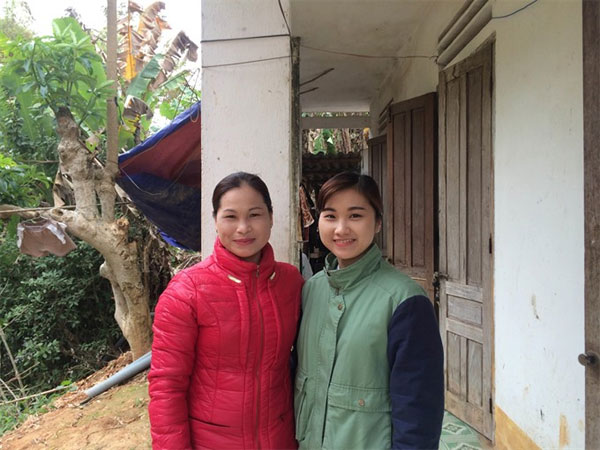
|
|
Unusual office pals: Mother and daughter team at Cho Ra Meteorological Station. – Photos: Thanh Binh/VNS |
There were no local residents, no paved roads, no market and, of course, no electricity. It was accessible only by boat.
Four times every day the men had to row a boat to the middle of the river and measure the water level.
When there’s a flood, they have to measure 24 hours a day, no matter how heavy the rain or how strong the water flow.
The hydrologists here collect data so that we at the National Centre of Hydro Meteorological Forecasting in Ha Noi can provide flood forecasts for midland and lowland river basins.
It was getting darker and we were crossing the forest to get to our boat and back to town. Late afternoon in the mountains was very quiet and boring. It was so foggy we could not see far. From the boat, we saw flickering lights along the river. There were few houses in each hamlet.
We were getting back to normal life on the other side of the Nang River. Then we came to Ba Be Lake. I could not tell where the water ended and the mountain began. We only saw one light in the distance.
We got to the shore a few minutes past seven. I looked up, the sky was full of stars. It turned out that it was only foggy above the water.
Had we left the hydro-station earlier, we would not have felt the solitude and isolation our colleagues experience every day.
When we left, the warmth we brought left with us. And they must have felt even more isolated.
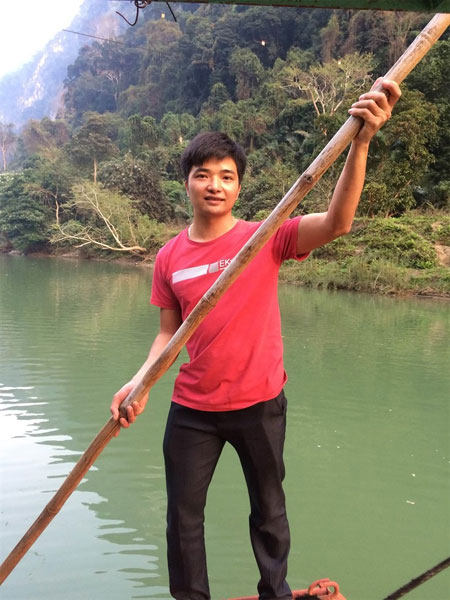
|
|
Youth energy: Nong Van Tiep from Bac Kan. |
Five young men
The five young men I met at the Dau Dang Hydrological Station joined us for dinner at the centre of Ba Be Park that evening. Each had a story to tell.
Nong Van Chat, 31, was an ethnic Tay man from Ba Be District. I asked why he decided to take this job. He said, “Well, I saw that the station was being built, then I thought I’d go to school and then go to work at the station.” What a simple job decision!
After three years studying at the Natural Resources and Environment School in Ha Noi, he went to work at the Station, where he has been for several years.
“How much do you make?” I asked.
“I get a little more than VND2 million,” he said with a shy smile. That is less than US$100. From the shine in his eyes, I knew that he would keep working despite the meager income.
Money here does not matter as much as in town because there’s little opportunity to spend it. The closest market takes place only once every five days and it’s hard to get to. It has to be approached by boat, crossing the Na Hang hydro-power reservoir. Even if you have a little more money to buy food, you can’t keep it for long without a fridge. They hydrologists grow their vegetables and raise chickens. They are almost totally self-sustaining.
So being a meteo-hydrologist in a remote station means you need to not only know how to do your job, but also have some basic knowledge in poultry raising and gardening to survive.
Tiep’s story
The second man we met, Nong Van Tiep, 32, is from Bac Kan Province. Still single, Tiep exudes a cheery spirit. He brought out two big cans of rice liquor he had distilled using herbal fermentation. It was so soothing, the liquor. Tiep and his men spent an hour rowing their boat to the bigger station to have dinner with us. He would have to row yet another hour back for the 1am report.
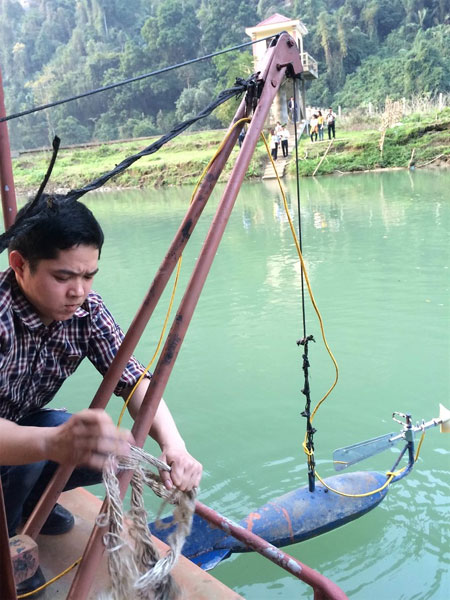
|
|
Vital work: Vi Duc Manh examines the cable that connects the current meter apparatus in the shape of a steel fish. |
In his heavy accent, Tiep said to us, “During flood time, I can swim, but the rules are that you must not leave the boat. I’m not afraid of heavy rain, nor strong flood. I’m only afraid of losing the steel fish (a weight with a flowmeter inside). I know how to deal with this situation. I learned it all at the weather school in Cau Dien on the outskirts of Ha Noi.
The fish weight has a little apparatus inside that measures the current flow, its depth and the level of turbidity in the current. It’s tied with a cable to a point lower downstream.
It takes four to record data in case such a flood hits. And when a flood hits, they need to be out there measuring the water every hour.
“Data is important. Even more so during a flood. One person steadies and rows the boat, one holds the cable and one takes notes. The fourth guy has to take a single boat upstream and clear all the floating wood and tree trunks out of the way. If the fish weight gets stuck and carried away by a log, then that’s it! If the weight gets stuck in a log, then it’s flushed away and the cable breaks.”
The third guy we met was Vi Duc Manh, 30. He’s signed a contract and is a permanent staff member, so his wages are higher.
“I work here, so that I can be close to home,” Manh said. “Close” for him means working 100km away from home. “I get to go home once a month.”
Every time he goes home, he puts his motorbike on the boat and then when he gets to shore, he drives home.
In charge of the station is Nguyen Huy Hoang. He’s stationed in Dau Dang but his wife and children live in Thai Nguyen. He also goes home once a month, and has a very special assignment at the same time: picking up the monthly payment for everyone else at the station. Everyone entrusted him with their bank cards and passwords. If they hadn’t done so, there would have been no way for them to withdraw cash from the accounts. Hoang’s wife and children have come up to Dau Dang to see him only twice since he started there.
“Then why doesn’t your wife come here to see you more, it’s so beautiful!” asks a young reporter traveling in the visitors’ group. Hoang looked down, and did not answer.

|
|
Forest spot: Twilight sets in at Dau Dang Hydrological Station. |
If one were to ask me what impressed me most when I visited Dau Dang, I would say first, the green young rice paddy, clean and beautiful at the foot of the station. Secondly, the men’s restroom was also surprisingly clean.
They also raise many chickens along with cats and dogs. Life seemed normal when I saw two mother hens taking their chicks out into the garden.
But Dau Dang is not the most isolated or least accessible station. “Stations in Hoang Su Phi or Dong Van districts of Ha Giang Province are tougher to work in,” one of my colleagues said when we moved on to the next destination.
Mother-daughter team
The Cho Ra Meteo-Hydrological station sits on top of a hill covered by different kinds of banana and bamboo plants.
The house is modest. The least comfortable of all the places we visited this time. Stationed there is a tiny family consisting of a mother, Hoang Thi Tinh, and daughter, Ma Thi Minh Hao, a fresh graduate of the Natural Resources and Environment College. Both mother and daughter measure and send their reports every single day of the year, including New Year’s Eve and New Year’s Day.
When I posted a description about my visit to Cho Ra Station and this special mother-daughter team, some of my colleagues commented, “These are the excellent employees of our company. We wish to meet them in Ha Noi one day!”
The next station we visited in Bac Kan was a brand new house. Flowers and vegetables grow everywhere around the house. The residential house is located behind the office. A tranquil river runs lazily behind it. Life seems so peaceful here for the staff, all of them are very young, energetic and cheerful.
My colleague in Ha Noi, a hydrologist named Bui Dinh Lap, heads a team that works every day with the data provided by the stations located in the mountains. They send in the data for all the rivers in the north and all the hydro-power reservoirs, including Na Hang right below Dau Dang Station.
Lap works closely with all the men and women everyday. But they rarely meet. He had only been to Dau Dang once before. This was his second time.
But the hosts were so busy preparing to receive our big group of 30 visitors, they did not have time to chat.
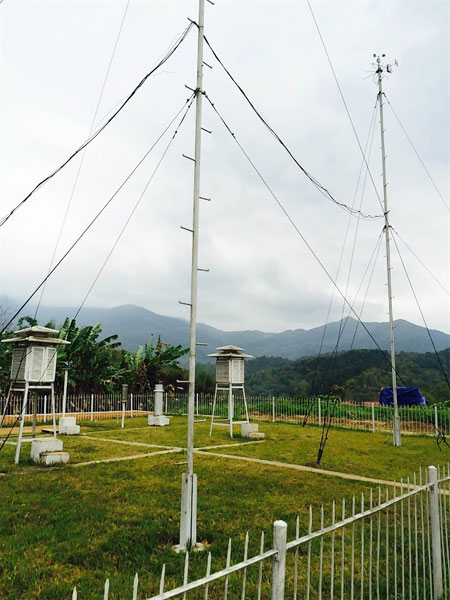
|
|
Measuring nature: the meteorological apparatus garden at Cho Ra. |
We all turned even more silent on our way back. We all were overwhelmed by our visit and the people we met. They talked very little, kept to themselves. They lived and worked and hoped for improvement in their lives and work.
Their stories moved us. In the fading afternoon light, their tidy house in the middle of a vegetable garden, the chickens searching for food, the lazy dogs lying in the front yard and the cats that ran away to hide from us. It’s such a peaceful pastoral life. No complaints about the low pay or lack of comfort. They would all say, "It’s our duty!"
If you, dear reader, would backpack and one day drop by their stations, you’d be welcome to stay overnight, and maybe chat with them over some home-grown food about their work. But be prepared for them to get up and leave so they can measure the river for the 1am report.

|
|
From left: Nong Van Tiep, Vi Duc Manh, Nguyen Thanh Binh (author) Nong Van Chat and Nong Van Thuan at the Dau Dang Station. 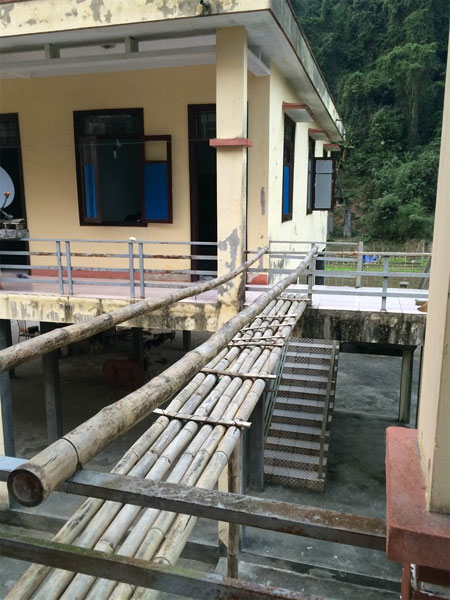 Bamboo bridging: The bridge between two buildings, built to secure connection in time of flood at Dau Dang Station.
|
Nguyen Thanh Binh*
VNS
| related news |